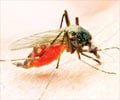
‘More than 200 million people contract malaria worldwide each year, and over 400,000 people die annually of this disease, according to statistics from the World Health Organization. Caused by protozoa in the genus Plasmodium, malaria kills mostly children, with the majority of deaths in sub-Saharan Africa.’
Tweet it Now
“Together, these and other behavioral phenomena suggest that Plasmodium has a sense of time,” says study leader Joseph S. Takahashi, Ph.D., chair of neuroscience at UTSW and a Howard Hughes Medical Institute investigator. “But the reason for these daily rhythms has been mysterious.”
Although the prevailing theory has been that Plasmodium takes its cues from its animal hosts, Takahashi – who studies biological clocks – and his colleagues suspected that the parasite has its own internal clock that drives this behavior. To investigate this hypothesis, Filipa Rijo-Ferreira, Ph.D., a postdoctoral research fellow and Howard Hughes Medical Institute associate who pioneered the project in the lab, worked with a mouse model of malaria infected by Plasmodium chabaudi. Like human patients, these animals also have cyclic fevers, about once per day.
To see whether the parasite’s rhythms are affected by light-dark cycles, which drive many circadian rhythms in humans and other animals, the researchers housed some infected mice in conditions that mimicked a regular day-night cycle, with 12 hours of light and 12 hours of darkness. Other mice were housed in complete darkness. For three days, the researchers collected blood from the animals and probed gene expression of their malaria parasites.
The researchers saw that of the 5,244 genes expressed by the blood stage of Plasmodium, more than 80 percent had the same cyclic patterns of expression in both lighting conditions. The activity of these genes peaked at the same time and with the same intensity in both groups, suggesting that the lighting cues that drive biological clocks in their mouse hosts weren’t affecting rhythms for the parasites.
To see if the clock in Plasmodium still ran about 24 hours, even if the clocks in their hosts do not, the researchers studied the parasite’s gene activity in mice with a genetic mutation that causes their own circadian rhythms to run about 26 hours instead of the usual 24. Tests showed that the protozoa seemed to slow their cell cycles to match those of their hosts, stretching them out to cover the 26-hour period. However, this correlation wasn’t perfect – Plasmodium’s gene expression lagged behind, taking several days to catch up with its long-period host. These findings suggest that although the parasite seems to take cues from its host, it still ran on its own time.
Advertisement
However, in this latter case, the parasite’s rhythms gradually became dysregulated over time. These findings suggest that although individual parasites appear to be driven by their own biological clocks, they seem to need an external cue from their hosts to synchronize. Mathematical models that the researchers constructed support this idea.
Advertisement
“This could add a whole new dimension to therapeutic treatment for this often fatal disease,” says Takahashi, a member of UT Southwestern’s Peter O’Donnell Jr. Brain Institute who holds the Loyd B. Sands Distinguished Chair in Neuroscience.
Other UTSW researchers who contributed to this study include Victoria A. Acosta-Rodriguez, Izabela Kornblum, and Gokhul Kilaru. Collaborators included Ines Bento and Maria M. Mota from the Instituto de Medicina Molecular, Lisbon, Portugal; John Abel, Massachusetts General Hospital and Massachusetts Institute of Technology, Boston; and Elizabeth B. Klerman, Brigham and Women’s Hospital, Boston.
This research was supported by funds from the Howard Hughes Medical Institute, NIH NIA F32-AG064886, NIH T32-HLO9701, NIH R01-HL128538, NIH K24-HL105664, and NIH P01-AG009975, the MGH Department of Neurology, and PTDC/BIA-MOL/30112/2017, PTDC/MED-IMU/28664/2017, FCT grants (PTDC/BIA-MOL/30112/2017 and PTDC/MED-IMU/28664/2017), and NIH NIGMS 1K99GM132557-01.
Source-Newswise













